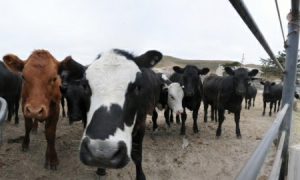
By Heather Smith
With just one slaughterhouse remaining within 80 miles of San Francisco, we stand to lose not only our local beef industry, but our grazing lands as well. Now a thick-skinned herd of ranchers and environmentalists are determined to keep the cows close to home.
In this era of the locavore, menus no longer merely inform diners what they’ll be eating. They also tell the story—often as elaborate as a bildungsroman—of where the ingredients in a dish were raised. Those dry-farmed Early Girl tomatoes in your salad? They once lived in a field near Santa Cruz. Those baby Chioggia beets? Tugged from organic dirt in Watsonville, then transported to restaurants in a biodiesel-fueled pickup. That rosemary-rubbed hanger steak? It was once a cow roaming the hillsides of West Marin with no more hormones than its own pituitary gland could produce.
What you won’t find out as readily is precisely where the cow made the transition from cavorting weed eater to inhabitant of a restaurant’s walk-in. That omission is unfortunate, because where an animal dies is as integral to the definition of local food as where it lived.
Continue reading To Eat Local, Kill Local

